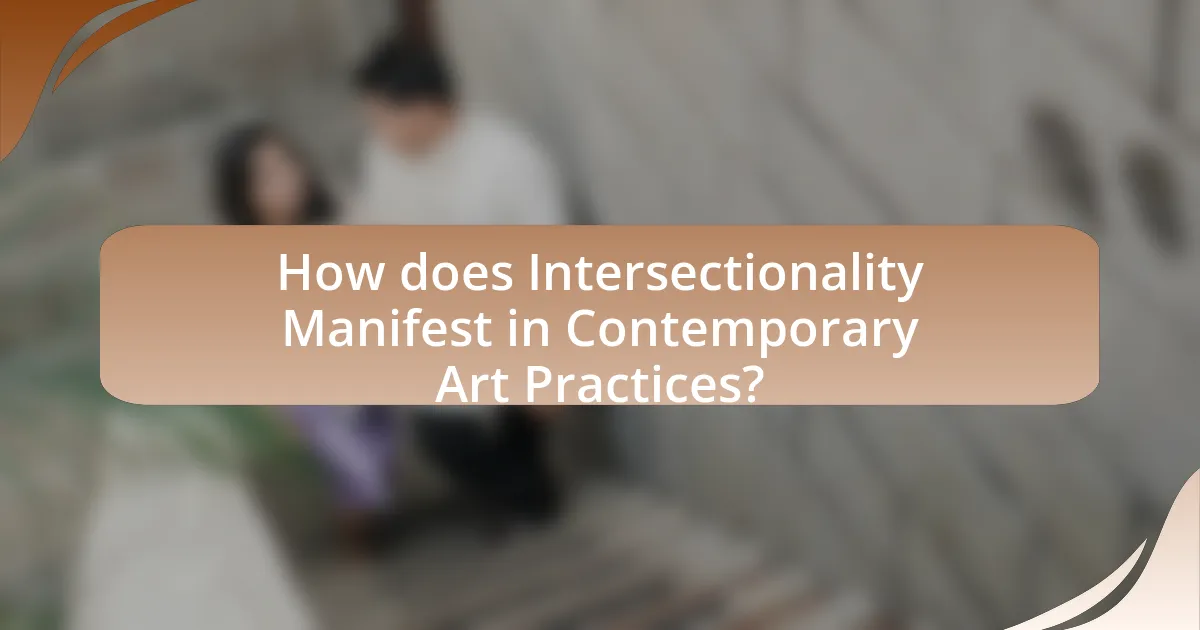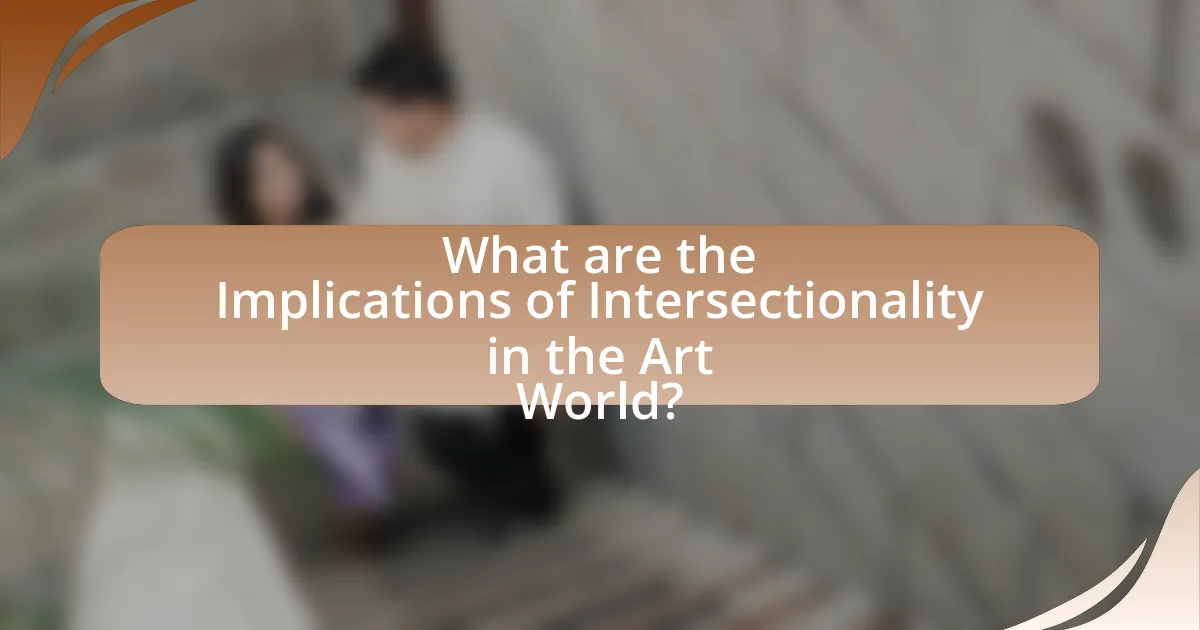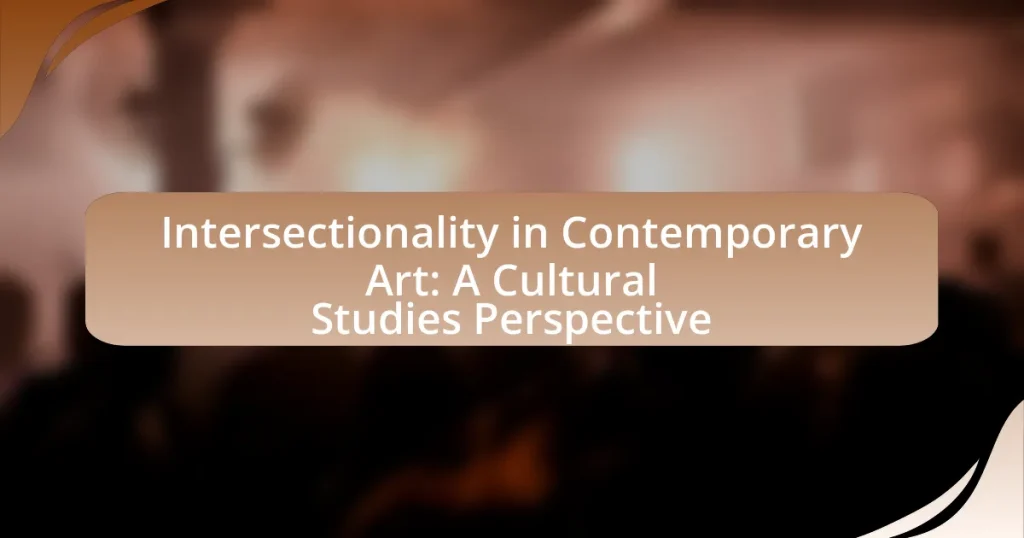Intersectionality in contemporary art is an analytical framework that examines how various social identities—such as race, gender, sexuality, and class—intersect to influence artistic expression and individual experiences. The article explores how artists like Kara Walker and Ai Weiwei utilize intersectionality to critique systemic inequalities and challenge dominant narratives, thereby enriching the understanding of art through diverse perspectives. Key components discussed include identity, power dynamics, and social context, along with methodologies from cultural studies that analyze art’s relationship with societal structures. The implications of intersectionality in the art world are also examined, highlighting its impact on audience perception, market dynamics, and future directions for artistic practices.

What is Intersectionality in Contemporary Art?
Intersectionality in contemporary art refers to the analytical framework that examines how various social identities—such as race, gender, sexuality, and class—intersect and influence individual experiences and artistic expression. This concept highlights the complexity of identity and the ways in which systemic inequalities manifest in art practices and interpretations. For instance, artists like Kara Walker and Ai Weiwei utilize their work to address and critique the intersections of power, oppression, and identity, thereby illustrating how these factors shape cultural narratives. The significance of intersectionality in contemporary art is underscored by its ability to foster a more inclusive understanding of diverse perspectives, as evidenced by the increasing representation of marginalized voices in major art institutions and exhibitions.
How does intersectionality influence artistic expression?
Intersectionality influences artistic expression by allowing artists to explore and represent the complexities of identity, including race, gender, sexuality, and class. This multifaceted approach enables artists to create works that reflect the diverse experiences and struggles of marginalized communities. For instance, artists like Kerry James Marshall and Frida Kahlo have utilized their unique perspectives shaped by their intersecting identities to challenge dominant narratives and highlight social injustices. Research indicates that intersectional frameworks in art can foster greater empathy and understanding among audiences, as they engage with the nuanced realities of different social groups.
What are the key components of intersectionality in art?
The key components of intersectionality in art include identity, power dynamics, and social context. Identity encompasses the various social categories such as race, gender, sexuality, and class that intersect to shape individual experiences and perspectives in artistic expression. Power dynamics refer to the ways in which these identities influence access to resources, representation, and authority within the art world. Social context involves the historical and cultural backgrounds that inform the creation and interpretation of art, highlighting how societal structures impact artistic narratives. These components collectively illustrate how intersectionality enriches the understanding of art by revealing the complexities of lived experiences and the multifaceted nature of oppression and privilege.
How do artists incorporate intersectional themes in their work?
Artists incorporate intersectional themes in their work by exploring the interconnectedness of various social identities, such as race, gender, sexuality, and class. This approach allows them to address complex societal issues and highlight the unique experiences of marginalized groups. For instance, artists like Kara Walker and Ai Weiwei use their platforms to critique systemic oppression and challenge dominant narratives, effectively illustrating how multiple identities shape individual experiences. Research indicates that intersectional art fosters greater empathy and understanding among audiences, as it encourages viewers to consider diverse perspectives and the nuances of identity.
Why is a cultural studies perspective important in understanding intersectionality in art?
A cultural studies perspective is important in understanding intersectionality in art because it allows for the analysis of how various social identities, such as race, gender, and class, intersect and influence artistic expression and interpretation. This perspective emphasizes the contextual factors that shape both the creation and reception of art, highlighting how power dynamics and cultural narratives impact representation. For instance, scholars like bell hooks and Stuart Hall have demonstrated that art cannot be separated from the socio-political contexts in which it exists, thus revealing how intersectional identities inform artistic practices and audience engagement. This approach fosters a deeper comprehension of the complexities within art, making it essential for a nuanced understanding of intersectionality.
What methodologies are used in cultural studies to analyze art?
Cultural studies employ various methodologies to analyze art, including semiotics, discourse analysis, ethnography, and visual culture studies. Semiotics focuses on the signs and symbols within artworks, allowing for the interpretation of meaning and cultural significance. Discourse analysis examines the language and narratives surrounding art, revealing power dynamics and societal contexts. Ethnography involves immersive observation and participation, providing insights into the cultural practices and communities that produce and engage with art. Visual culture studies analyze the role of visual media in shaping cultural identities and social relations. These methodologies collectively enable a comprehensive understanding of art within its cultural and social frameworks.
How does cultural context shape the interpretation of intersectional art?
Cultural context significantly shapes the interpretation of intersectional art by influencing the meanings and values attributed to the artwork. For instance, the historical and social backgrounds of both the artist and the audience can affect how themes of race, gender, and class are perceived within the art. Research indicates that artworks created in specific cultural contexts often reflect the struggles and narratives of marginalized communities, which can lead to varied interpretations based on the viewer’s own cultural experiences. For example, a piece addressing racial identity may resonate differently with audiences from diverse ethnic backgrounds, as their personal histories and societal positions inform their understanding of the artwork. This dynamic interplay between cultural context and interpretation underscores the importance of situating intersectional art within its specific cultural framework to fully grasp its intended messages and implications.

How does Intersectionality Manifest in Contemporary Art Practices?
Intersectionality manifests in contemporary art practices through the integration of diverse identities and experiences, reflecting the complexities of social categories such as race, gender, sexuality, and class. Artists utilize intersectionality to challenge dominant narratives and highlight marginalized voices, often employing mixed media, collaborative projects, and community engagement to create inclusive dialogues. For instance, exhibitions like “The Black Index” at the Museum of Contemporary Art in Los Angeles showcase how artists address systemic inequalities by intertwining personal and collective histories, thereby reinforcing the validity of intersectional approaches in art. This practice not only broadens the scope of artistic expression but also fosters critical conversations about social justice and representation in the art world.
What are the different forms of intersectional art?
Intersectional art manifests in various forms, including visual art, performance art, literature, and multimedia installations. Visual art often incorporates diverse cultural symbols and narratives to address issues of race, gender, and class, as seen in the works of artists like Kerry James Marshall and Frida Kahlo. Performance art engages audiences through live expressions that challenge societal norms, exemplified by artists such as Marina Abramović and Yoko Ono. Literature, particularly poetry and prose, explores intersectionality through storytelling that reflects multiple identities, as demonstrated by authors like Audre Lorde and Chimamanda Ngozi Adichie. Multimedia installations combine technology and traditional art forms to create immersive experiences that highlight intersectional themes, as seen in the works of artists like Shirin Neshat. These forms collectively contribute to a broader understanding of intersectionality in contemporary art, emphasizing the interconnectedness of social identities and experiences.
How do various mediums express intersectional themes?
Various mediums express intersectional themes by utilizing diverse forms of representation that highlight the interconnectedness of social identities such as race, gender, class, and sexuality. For instance, visual art often employs mixed media to juxtapose different cultural symbols, allowing artists to convey complex narratives that reflect multiple perspectives. Literature, through character development and plot, can explore the nuances of identity and systemic oppression, as seen in works by authors like Chimamanda Ngozi Adichie, who addresses the intersections of gender and ethnicity. Performance art frequently embodies intersectionality by engaging audiences in real-time discussions about social issues, as demonstrated by artists like Marina Abramović, who challenges societal norms through her performances. These mediums collectively provide a platform for marginalized voices, fostering a deeper understanding of how various identities interact within societal structures.
What role does performance art play in intersectionality?
Performance art serves as a vital medium for exploring and expressing intersectionality by highlighting the interconnectedness of various social identities and systemic oppressions. Through live performances, artists can embody and communicate the complexities of race, gender, sexuality, and class, allowing audiences to engage with these multifaceted experiences in real-time. For instance, artists like Marina Abramović and Yoko Ono have utilized their performances to challenge societal norms and provoke discussions around identity and power dynamics, illustrating how performance art can reveal the nuances of intersectional identities. This engagement fosters a deeper understanding of how different forms of discrimination overlap, making performance art a powerful tool for social commentary and activism within the framework of intersectionality.
How do artists from diverse backgrounds approach intersectionality?
Artists from diverse backgrounds approach intersectionality by integrating their unique cultural, social, and personal experiences into their work, thereby highlighting the interconnectedness of various identities. This approach often manifests in the exploration of themes such as race, gender, sexuality, and class, allowing artists to challenge dominant narratives and provide a more nuanced understanding of societal issues. For instance, artists like Kerry James Marshall and Frida Kahlo have used their art to reflect on the complexities of identity and the impact of systemic oppression, demonstrating how intersectionality can inform artistic expression and critique.
What unique perspectives do marginalized artists bring to intersectional art?
Marginalized artists bring diverse lived experiences and cultural narratives to intersectional art, enriching its complexity and depth. Their perspectives often highlight issues of identity, oppression, and resilience, which are frequently overlooked in mainstream art. For instance, artists from LGBTQ+ communities, racial minorities, and those with disabilities create works that challenge dominant narratives and reflect the multifaceted nature of human experience. This is evidenced by the rise of movements like Black Lives Matter, which has inspired numerous artists to address systemic racism through their art, thus fostering a dialogue that is essential for understanding intersectionality. Additionally, studies show that art created by marginalized groups often incorporates elements of their cultural heritage, providing a platform for voices that have been historically silenced, thereby enhancing the richness of intersectional art.
How does collaboration among artists enhance intersectional narratives?
Collaboration among artists enhances intersectional narratives by integrating diverse perspectives and experiences, which allows for a richer and more nuanced representation of complex social identities. When artists from different backgrounds collaborate, they bring unique cultural insights and lived experiences that challenge monolithic narratives, thereby fostering a more inclusive dialogue. For instance, projects like “The Black Artists + Designers Guild” showcase how collective efforts can amplify underrepresented voices, creating art that reflects the intersections of race, gender, and class. This collaborative approach not only broadens the scope of artistic expression but also engages audiences in critical conversations about identity and social justice, ultimately enriching the cultural landscape.

What are the Implications of Intersectionality in the Art World?
Intersectionality in the art world implies that artists’ identities, shaped by factors such as race, gender, sexuality, and class, influence their work and the reception of that work. This multifaceted approach allows for a deeper understanding of how diverse perspectives enrich artistic expression and challenge dominant narratives. For instance, the work of artists like Kerry James Marshall and Frida Kahlo illustrates how their unique experiences inform their art, prompting discussions about representation and inclusivity. Research by the National Endowment for the Arts highlights that diverse artistic voices contribute to a more vibrant cultural landscape, demonstrating that intersectionality not only impacts individual artists but also shapes broader art movements and institutions.
How does intersectionality challenge traditional art narratives?
Intersectionality challenges traditional art narratives by highlighting the interconnectedness of social identities and power structures that shape artistic expression and interpretation. This approach reveals how factors such as race, gender, class, and sexuality influence both the creation and reception of art, thereby questioning the dominant narratives that often marginalize diverse voices. For instance, artists like Kara Walker and Ai Weiwei utilize their identities to critique historical and cultural contexts, demonstrating that traditional art narratives often overlook the complexities of lived experiences. By incorporating intersectional perspectives, contemporary art expands the discourse, allowing for a more inclusive understanding of artistic value and significance.
What impact does intersectional art have on audience perception?
Intersectional art significantly influences audience perception by challenging dominant narratives and fostering empathy through diverse representations. This form of art engages viewers by highlighting the complexities of identity, including race, gender, sexuality, and class, which encourages a deeper understanding of social issues. Research indicates that exposure to intersectional art can lead to increased awareness and sensitivity towards marginalized communities, as evidenced by studies showing that audiences often report heightened emotional responses and a greater willingness to engage in social justice discussions after experiencing such artworks.
How does intersectionality influence art market dynamics?
Intersectionality influences art market dynamics by shaping the visibility and valuation of diverse artists and their works. This framework highlights how overlapping social identities, such as race, gender, and class, affect individuals’ experiences and opportunities within the art market. For instance, research indicates that galleries and auction houses increasingly prioritize artists from marginalized backgrounds, recognizing that their unique perspectives can attract a broader audience and enhance market value. A study by the Art Basel and UBS Global Art Market Report (2021) shows that artworks by women and artists of color have seen significant price increases, reflecting a shift in collector interest towards inclusivity and diversity. This trend demonstrates that intersectionality not only impacts the representation of artists but also drives economic changes within the art market.
What are the future directions for intersectionality in contemporary art?
Future directions for intersectionality in contemporary art include a deeper integration of diverse identities and experiences, emphasizing the interconnectedness of race, gender, sexuality, and class. Artists are increasingly exploring these intersections to challenge dominant narratives and create more inclusive representations. For instance, exhibitions like “The Black Index” at the Museum of Contemporary Art in Los Angeles highlight how artists use intersectional frameworks to address systemic inequalities. This trend reflects a growing recognition of the importance of multiple identities in shaping artistic expression and audience engagement, fostering a more nuanced understanding of cultural production.
How can emerging artists leverage intersectionality in their work?
Emerging artists can leverage intersectionality in their work by intentionally incorporating diverse identities and experiences into their artistic narratives. This approach allows them to challenge dominant cultural norms and highlight the complexities of social issues, such as race, gender, and class. For instance, artists like Kehinde Wiley and Frida Kahlo have utilized their backgrounds to create works that reflect multifaceted identities, thereby fostering a deeper understanding of intersectional experiences. By doing so, they not only engage a broader audience but also contribute to a more inclusive art discourse that recognizes the interconnectedness of various social categories.
What role does technology play in the evolution of intersectional art?
Technology serves as a catalyst in the evolution of intersectional art by enabling diverse voices and perspectives to be amplified and shared globally. Digital platforms and social media allow artists from various backgrounds to connect, collaborate, and showcase their work, breaking down traditional barriers to entry in the art world. For instance, the rise of online galleries and virtual exhibitions has democratized access to art, allowing marginalized artists to reach wider audiences without the constraints of physical space. Additionally, technology facilitates innovative artistic practices, such as digital installations and interactive media, which can engage viewers in new ways and reflect the complexities of identity and experience. This integration of technology not only enhances the visibility of intersectional narratives but also fosters a more inclusive dialogue within contemporary art.
What practical strategies can artists use to incorporate intersectionality into their work?
Artists can incorporate intersectionality into their work by actively engaging with diverse perspectives and experiences. This can be achieved through collaboration with individuals from various backgrounds, ensuring representation of marginalized voices in their projects. For instance, artists can conduct community workshops that invite participants to share their stories, which can then inform the themes and narratives in their artwork. Additionally, artists can utilize mixed media to reflect the complexity of identities, combining visual elements that represent different cultural, racial, and gender identities. Research indicates that artworks that embrace intersectionality resonate more deeply with audiences, as they reflect the multifaceted nature of human experience, thereby fostering greater empathy and understanding.










